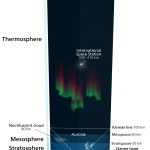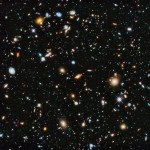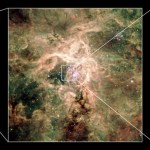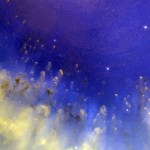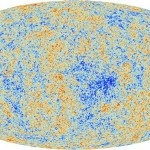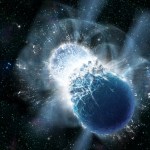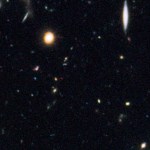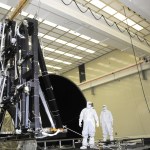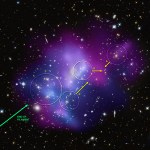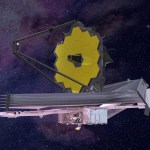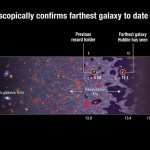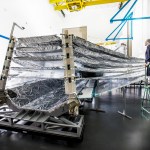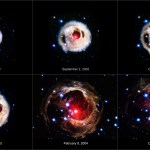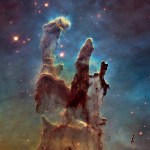Hubble
"When we meet real tragedy in life, we can react in two ways - either by losing hope and falling into self-destructive habits, or by using the challenge to find our inner strength." -Dalai Lama
Orbiting at hundreds of miles above Earth’s atmosphere, you’d think the Hubble Space Telescope would be safe and stable for a long time. But despite our definitions, Earth’s atmosphere doesn’t “end” and space doesn’t “begin” when we get 60 miles (100 kilometers) up. Instead, Earth’s atmosphere continues, albeit tenuously, for incredible distances, until it eventually merges with the solar wind. It’s…
"Truth in science, however, is never final, and what is accepted as a fact today may be modified or even discarded tomorrow. Science has been greatly successful at explaining natural processes, and this has led not only to increased understanding of the universe but also to major improvements in technology and public health and welfare." -National Academy of Sciences
It’s no secret that peering out into the distant Universe is best done from space, just as looking at our entire world is best done from that same vantage point. For all of human history until the mid-20th century, this was an…
"Suddenly whole new programs open up, things you can do that you could never do before. It'd be great scientifically, it'd be great for the nation, for educators, for students, and it'd be just great for the public at large." -Garth Illingworth
Looking farther and farther into the distant Universe is the equivalent of looking farther and farther back in time. Although Hubble has shown us galaxies from when the Universe is just 400 million years old, and satellites to measure the Cosmic Microwave Background can show us a snapshot at 380,000 years, we have no information about what’s in between…
"The physicist is like someone who’s watching people playing chess and, after watching a few games, he may have worked out what the moves in the game are. But understanding the rules is just a trivial preliminary on the long route from being a novice to being a grand master. So even if we understand all the laws of physics, then exploring their consequences in the everyday world where complex structures can exist is a far more daunting task, and that’s an inexhaustible one I'm sure." -Martin Rees
It’s all too easy to take a look at a prediction that’s about something yet unproven and dismiss…
"The origin and evolution of life are connected in the most intimate way with the origin and evolution of the stars." -Carl Sagan
When it comes to dying stars, supernovae get all the press. They may be the largest and most massive stars to die, but hundreds of times more common are the planetary nebulae of the Universe, formed by dying Sun-like stars. These astronomical wonders blow off their outer layers -- not just hydrogen but also heavier elements -- to return them to the interstellar medium.
In this contrast-enhanced view, the structure of the evaporating gas globules at the interior…
“Gamow was fantastic in his ideas. He was right, he was wrong. More often wrong than right. Always interesting; … and when his idea was not wrong it was not only right, it was new.” -Edward Teller
100 years ago, our conception of the Universe was so small it's almost laughable. We still were mired in Newtonian thought, conceiving only of the stars within our own Milky Way, with a Universe that was perceived as static and unchanging, and where the stars which made it up perhaps even lived forever. Yet today, we have a Universe that's expanding, cooling, full of dark matter and dark energy, and…
“No matter what technique you use, you should get the same value for the expansion rate of the universe today.” -Ben Hoscheit
When you think of the Universe on the largest scales, you likely think of galaxies grouped and clustered together in huge, massive collections, separated by enormous cosmic voids. But there’s another kind of cluster-and-void out there: a very large volume of space that has its own galaxies, clusters and voids, but is simply higher or lower in density than average.
The construction of the cosmic distance ladder involves going from our Solar System to the stars to…
"N6946-BH1 is the only likely failed supernova that we found in the first seven years of our survey. During this period, six normal supernovae have occurred within the galaxies we've been monitoring, suggesting that 10 to 30 percent of massive stars die as failed supernovae." -Scott Adams
Everyone knows the recipe for a black hole: create a massive enough star, allow it to burn through the fuel it its core, and wait. After enough time, the core will collapse, creating a type II supernova and a runaway fusion reaction. The outer layers explode while the core implodes, leaving behind a black…
"We find them smaller and fainter, in constantly increasing numbers, and we know that we are reaching into space, farther and farther, until, with the faintest nebulae that can be detected with the greatest telescopes, we arrive at the frontier of the known universe." -Edwin Hubble
When you look out at the distant Universe, you can see all sorts of things: stars, galaxies, clusters of galaxies, going as far back into the distant past as our telescopes can image. But where you have the greatest concentrations of mass, an extreme phenomenon emerges: that of gravitational lensing. Any foreground…
"We’ve taken a major step back in time, beyond what we’d ever expected to be able to do with Hubble. We see GN-z11 at a time when the universe was only three percent of its current age." -Pascal Oesch
Arriving at our eyes after a journey of 13.4 billion years, the light from galaxy GN-z11 has been traveling towards us for 97% of the Universe’s present age. It’s detection and discovery, however, was a lot more complicated than simply opening up your telescope’s eyes and collecting enough light; a confluence of four separate things needed to happen all at once to make it possible.
Schematic…
"Hey, if our eyes could access the infrared part of the light spectrum, the sky would be green and trees would be red. Some animals see in completely different ways, so who knows what colors look like to them. Nothing is really how we perceive it." -Wendy Mass
If you take a look at the James Webb Space Telescope, the most visually striking feature of all is the gold mirrors. Yet gold would make an absolutely terrible material for constructing these mirrors! For very sound scientific reasons, the vast majority of these mirrors are made out of beryllium, not gold, and gold doesn't even enter…
"With the Hubble telescope and all the other things that are out there, I believe something would have come through. Today, I really believe we are unique." -Mark Goddard
Want to identify where stars are forming (or about to form) in the Universe? We’ve got no problem using visible light, which reveals unambiguous signatures associated with newborn stars. But if you want to view those stars themselves, or the processes occurring within the nebula where they’re being born? You have to go to infrared light.
Taken in infrared light, the image shows the dense column and the surrounding greenish-…
"On a cosmic scale, our life is insignificant, yet this brief period when we appear in the world is the time in which all meaningful questions arise." -Paul Ricoeur
When it comes to the largest bound cosmic structures, it doesn’t get any bigger than galaxy clusters. Unless, that it, you consider when multiple galaxy clusters merge together. Located at the intersections of cosmic dark matter filaments, smaller clusters flow into the larger clusters located at such a nexus. When we get very lucky, colliding clusters can be seen.
The combination of radio and X-ray data reveal background, lensed…
"For the first time we can learn about individual stars from near the beginning of time. There are surely many more out there." -Neil Gehrels
We know what NASA’s James Webb and WFIRST are designed for, and we know what we expect to find. James Webb will be the largest space telescope ever, focused mostly on infrared observations probing exoplanets, star-forming nebulae, galaxy evolution and the first stars and galaxies in the Universe. WFIRST will be just like Hubble, except with better instruments and 100 times the field-of-view.
The Hubble eXtreme Deep Field, our deepest view of the…
"The [James Webb] telescope is basically designed to answer the big questions in astronomy, the questions Hubble can't answer." -Amber Straughn
Have you ever asked the biggest questions in the Universe? Questions like how the Universe came to be the way it is today? How the first stars and galaxies -- the first light -- came to be in the Universe? Whether Earth-sized worlds around red dwarf stars have atmospheres, possibly with signatures of life? And what the Universe was like when the first stars were just forming? The James Webb Space Telescope was designed to answer these questions and…
"The problem is, you’re trying to find these really faint things, but you’re looking behind these really bright things. The brightest galaxies in the universe are in clusters, and those cluster galaxies are blocking the background galaxies we’re trying to observe." -Rachael Livermore
One of the biggest puzzles in science is exactly how the Universe became transparent to visible light. Neutral atoms -- cosmic dust -- blocks visible light, and yet before there were stars, that’s all we had. According to theory, it should be large numbers of small, faint, ultra-distant galaxies that made it…
"For the first time we can learn about individual stars from near the beginning of time. There are surely many more out there." -Neil Gehrels
We’ve come incredibly far in our quest to learn how the Universe came to be the way it is today. We can see out in space for tens of billions of light years, to galaxies as they were when the Universe was only a few percent of its present age. We can see how galaxies evolve, merge and the stars inside change. And we can see to even before that, when no stars or galaxies existed at all.
The farthest galaxy known to date, which was confirmed by Hubble,…
"One way or another the first stars must have influenced our own history, beginning with stirring up everything and producing the other chemical elements besides hydrogen and helium. So if we really want to know where our atoms came from, and how the little planet Earth came to be capable of supporting life, we need to measure what happened at the beginning." -John Mather
Launching in October of 2018, the James Webb Space Telescope will revolutionize our conception of the Universe. The biggest scientific find that we know it can uncover is how the Universe came to be the way it is today. How…
"We have chased away the clouds, the sky is all 'rose.'" -Francois Hollande
When you have a light curve with two different large, periodic dips in it, a binary star system is the likeliest explanation. The stars eclipse, and in the case where they're so close their envelopes touch, they're known as contact binaries. That, alone, is enough to make a system spectacular.
Contact binaries come in all sorts of different masses and sizes, but cannot be directly observed or resolved by current telescopes. Image credit: ESO/L. Calçada.
But in the case of this system, KIC 9832227, the orbital…
“The history of astronomy is a history of receding horizons.” -Edwin Hubble
Over its more than 25 year lifetime, the Hubble Space Telescope has shown us what the Universe truly looks like. It’s done so in a myriad of ways, from planets to stars – dying and forming – to galaxies to gravity’s effects to the deepest abysses of blackness of all. Nothing in space is the same as it was before humanity knew Hubble. Yet even the camera most responsible for our iconic images, WFPC2, isn’t the end of the story.
The gravitationally interacting system, Arp 147. Image credit: Arp 147, via NASA, ESA, and…
